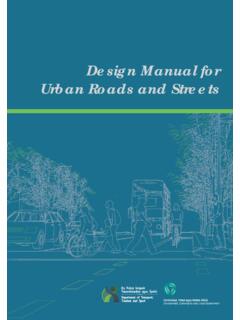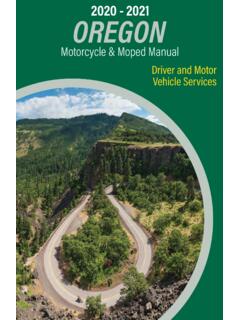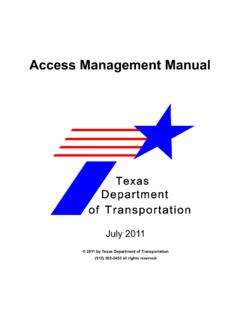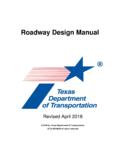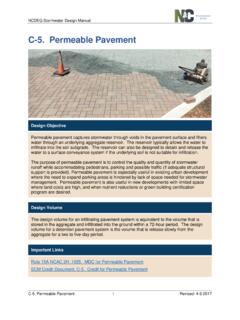Transcription of D.C. Temporary Traffic Control Manual
1 TrafficControlManual2006 EditionTraffic Services AdministrationGovernment of the District of ColumbiaAnthony A. Williams, MayorDISTRICT DEPARTMENT OF and Traffic Control ManualGuidelines and line indicates edge of binder Temporary Traffic Control Manual July 2006 i TABLE OF CONTENTS Page SECTION 1 - INTRODUCTION .. 1-1 SECTION 2 - GENERAL 2-1 General .. Responsibility .. 2-2 Definitions of Words and Phrases in this Manual .. 2-4 Minimum 2-13 Special Events, Holidays, Inaugurations .. 2-13 Abbreviations used on Traffic Control Devices .. 2-13 SECTION 3- FUNDAMENTAL PRINCIPLES OF Temporary Traffic Control .. 3-1 Fundamental 3-1 SECTION 4 - Temporary Traffic Control ELEMENTS.
2 4-1 Temporary Traffic Control 4-1 Temporary Traffic Control 4-3 Components of Temporary Traffic Control Zones .. 4-4 Advance Warning Area .. 4-4 Transition 4-6 Buffer Space Area .. 4-6 Activity Area .. 4-8 Termination Area .. 4-9 Detours and 4-13 One-Lane, Two-Way Traffic Control .. 4-13 Flagger Method of One-Lane, Two-Way Traffic Control .. 4-14 Pilot Car Method of One-Lane, Two-Way Traffic Control .. 4-14 Temporary Traffic Control Signal Method of One-Lane, Two-Way Traffic Control .. 4-15 SECTION 5 - PEDESTRIAN AND WORKER 5-1 Pedestrian Considerations .. 5-1 Worker Considerations .. 5-10 SECTION 6 - FLAGGER Control .. 6-1 Qualifications for Flaggers.
3 6-1 High-Visibility Clothing .. 6-1 Hand-Signaling Devices .. 6-2 Flagger 6-3 Flagger Stations .. 6-6 Traffic Spotters .. 6-8 Temporary Traffic Control Manual July 2006 ii TABLE OF CONTENTS (Continued) Page SECTION 7 - Temporary Traffic Control ZONE 7-1 Types of 7-1 General Characteristics of Signs .. 7-1 Sign 7-3 Sign 7-6 Regulatory Sign Authority .. 7-6 Regulatory Sign Design .. 7-7 Regulatory Sign Applications .. 7-7 Advance Warning Signs .. 7-10 Special Regulatory 7-12 Warning Signs: Function, Design, and Application .. 7-12 Position of Advance Warning Signs.
4 7-14 Other Warning Signs .. 7-24 Special Warning Signs .. 7-24 Guide Signs .. 7-25 Detour 7-27 Pilot Car Signs .. 7-28 Portable Changeable Message Signs .. 7-28 Arrow 7-31 High-Level Warning Devices (Flag Trees).. 7-36 Channelizing Devices .. 7-36 Cones .. 7-40 Tubular Markers .. 7-41 Vertical 7-42 Drums .. 7-42 Type III 7-43 Direction Indicator Barricades .. 7-45 Temporary Traffic Barriers as Channelizing 7-45 Other Channelizing 7-46 Temporary Raised 7-46 Pavement Markings .. 7-47 Temporary Pavement 7-48 Raised Pavement 7-49 Delineators .. 7-49 Lighting Devices .. 7-50 7-50 Flashing Warning 7-51 Warning 7-52 Steady-Burn Electric Lamps.
5 7-53 Vehicle Warning Lights .. 7-53 Temporary Traffic Control 7-54 Temporary Traffic 7-55 Crash Cushions .. 7-57 Temporary Traffic Control Manual July 2006 iii TABLE OF CONTENTS (Continued) Page Vehicle-Arresting Systems .. 7-60 Rumble 7-60 Screens .. Future and Experimental Devices .. 7-61 SECTION 8 - TYPE OF Temporary Traffic Control ZONE ACTIVITIES .. 8-1 Typical Applications .. 8-1 Work Duration .. 8-1 Location of Work and Roadway Characteristics .. 8-5 Modifications to Fulfill Special Needs .. 8-6 Work off of the Roadway .. 8-7 Work on the Shoulder with No Encroachment .. 8-8 Work on the Shoulder with Minor Encroachment .. 8-10 Work within the Median.
6 8-10 Work within the Traveled Way of Two-Lane Highways .. 8-10 Work within the Traveled Way of Urban Streets .. 8-11 Work within the Traveled Way of Multilane, Non-access Controlled Highways .. 8-12 Work within the Traveled Way at 8-14 Work within the Traveled Way of Expressways and 8-16 Two-Lane, Two-Way Traffic on One Roadway of a Normally Divided 8-17 8-18 Interchanges .. 8-18 Movable Barriers .. 8-19 Work in the Vicinity of Highway-Rail Grade 8-19 Control of Traffic Through Incident 8-20 Work During Inclement 8-21 SECTION 9 - TYPICAL APPLICATIONS .. 9-1 SECTION 10 CRANE TYPICAL DETAILS .. 10-1 Crane 10-1 Crane Typicals .. 10-3 Temporary Traffic Control Manual July 2006 ivLIST OF FIGURES Page Figure 4-1.
7 Five Parts of Temporary Traffic Control Zone .. 4-5 Figure 5-1. Crosswalk Closure and Pedestrian Detour .. 5-3 Figure 5-2. Sidewalk Closure and Bypass Sidewalk Operation .. 5-4 Figure 5-3. Temporary Covered Walkway with Fencing at Intersection Corner .. 5-7 Figure 5-4. Temporary Covered Walkway at 5-8 Figure 6-1. Use of Hand Signaling Devices by Flagger .. 6-4 Figure 7-1. Height And Lateral Location Of Signs-Typical Installations .. 7-4 Figure 7-2. Commonly Used Regulatory Signs .. 7-8 Figure 7-4. Warning Signs in Temporary Traffic Control Zones .. 7-16 Figure 7-4. Warning Signs in Temporary Traffic Control Zones .. 7-17 Figure 7-4. Warning Signs in Temporary Traffic Control Zones .. 7-18 Figure 7-5. Exit Open and Closed and Detour 7-21 Figure 7-6. Arrow Panel displays .. 7-33 Figure 9-1. Typical Application: Closures on Curb Lanes.
8 9-5 Figure 9-2. Typical Application: Mobile or Short 9-7 Figure 9-3. Typical Application: Mobile Operations on a High-Speed Road .. 9-9 Figure 9-4. Typical Application: Moderate Duration or Stationary Operation .. 9-11 Figure 9-5. Typical Application: Closure in the Center of a Local or Low-Volume 9-13 Figure 9-6. Typical Application: Lane Closure on a Minor Street .. 9-15 Figure 9-7. Typical Application: Road Closure and Detour for One Travel Direction . 9-17 Figure 9-8. Typical Application: Road Closure and Detour for Two TravelDirections .. 9-19 Figure 9-9. Typical Application: Right Lane Closure at Far Side of the 9-21 Figure 9-10. Typical Application: Left Lane Closure at Far Side of the Intersection .. 9-23 Figure 9-11. Typical Application: Multiple Closures at Intersection .. 9-25 Figure 9-12.
9 Typical Application: Closure in Center of Intersection .. 9-27 Figure 9-13. Typical Application: Closure at Side of Intersection (With No Parking Lanes).. 9-29 Figure 9-14. Typical Application: Closure at Side of Intersection (With Parking Lanes) .. 9-31 Figure 9-15. Typical Application: Interior Lane Closure on Multi-Lane Roadway 9-33 Figure 9-16. Typical Application: Merging Taper Followed by Shifting Taper onMultilane 9-35 Figure 9-17. Typical Application: Multi-leg 9-37 Figure 9-18. Typical Application: Sidewalk Closure and Bypass Sidewalk Operation 9-39 Figure 9-19. Typical Application: Crosswalk Closures and Pedestrian 9-41 Figure 9-20. Typical Application: Covered Pedestrian Walkways Mid-Block Locations .. 9-42 Figure 9-21. Typical Application: Covered Pedestrian Walkways Corner Locations at Four -Way Intersections.
10 9-43 Figure 9-22. Typical Application: Construction Dumpster Located in Parking 9-44 Temporary Traffic Control Manual July 2006 vLIST OF FIGURES Page Figure 9-23. Typical Application: Construction Dumpster Located in Parking Lane(One-Way Road) .. 9-46 Figure 9-24. Typical Application: Construction Dumpster Located in Parking 9-47 Figure 9-24. Typical Application: Traffic Circle with Outer-most Lane Closure .. 9-48 Figure 9-25. Typical Application: Traffic Circle with Center Lane Closure .. 9-49 Figure 9-26. Typical Application: Traffic Circle with Inner-most Lane 9-50 Figure 10-1. Typical Details for 40 Ton 10-4 Figure 10-2. Typical Details for 50 Ton 10-4 Figure 10-3. Typical Details for 70 Ton 10-5 Figure 10-4. Typical Details for 120 Ton 10-6 Figure 10-5.












